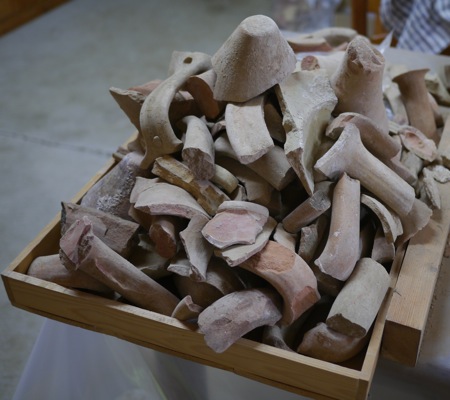Scott Moore and I are off to the museum this morning after a productive weekend. The Larnaka District Archaeological Museum stores the artifact from our excavations near Pyla Village. Our main goal for this field season of the Pyla-Koutsopetria Archaeological Project is to process the artifacts from the 2012 excavation season. In the afternoon, we dedicate our time to preparing for our season at Polis-Chrysochous on the western side of the island which will start in early June.
At Pyla-Koutsopetria, we had to start to process over 700 lbs of pottery as efficiently as possible over our 6, short days of access to the museum storerooms. This material all derives from a single deposit and was carefully excavated as a number of different stratigraphic units. Since we determined at the end of the season that the pottery comes from a single depositional event, we’ve been tempted to combine the various stratigraphic units identified in the field into a single unit for the purpose of processing pottery. (We’d keep the excavated contexts separate during the analysis process, but for the purposes of discussion and analysis all the pottery would appear as a single context.)

All the pottery derives from a 2 x 3 x 2 m storage pit on the inside of the Hellenistic fortification wall on Vigla. As the pit leaned up against the wall, it posts dates it and the content of the storage pit (which appears to have become a trash pit at some point) then provides a terminus ante quem (a point before which) for the wall itself. So, not only are the contents of pit of interest because they appear to directly relate to the cycle of destruction and clean up at the site, but they also help date the fortification. Since the material appears to be from the clean up deposit, it should reflect the range of material at the site and activities.
Next, we have to prepare for our season at Polis-Chrysochous which will start on June 2. This involves processing more of the excavation notebooks and determining which areas require some focused attention. Our goal is to have a publishable preliminary report on the basilica-style church at the site of E.F2 (in the Polis excavation grid) prepared by the end of the summer. Doing data entry and notebook study is not nearly as exciting as analyzing piles of relatively well-preserved pottery fragments, but every bit as necessary. We key the notebooks and sync them with both the inventoried artifacts (generally remarkable finds or nearly complete vessels) and the context pottery (the Cypriots call these “the sherds”, and they are usually broken up bits of pottery from all sorts of depositional contexts).
In fact, I’m going to start to type and analyze two Polis notebook the moment I’m done with this blog. More on this soon.

